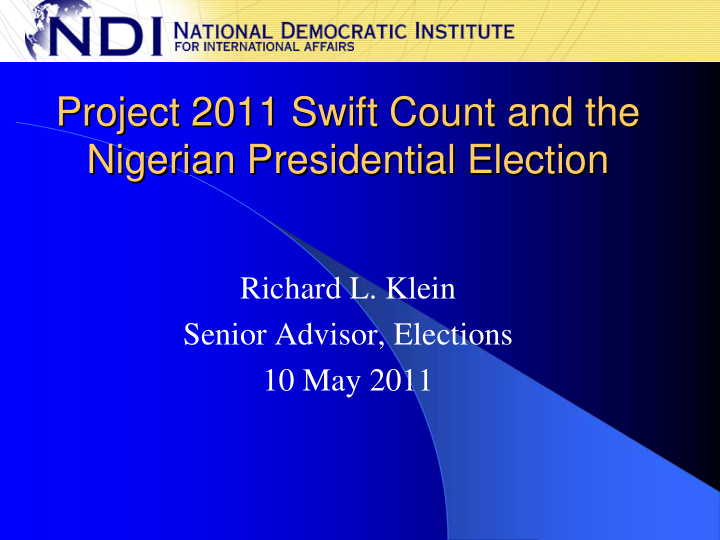



Project 2011 Swift Count and the Project 2011 Swift Count and the Nigerian Presidential Election Nigerian Presidential Election Richard L. Klein Senior Advisor, Elections 10 May 2011
Question Question � Were the official results for the presidential election as announced by the electoral authorities accurate?
Project 2011 Swift Count Project 2011 Swift Count � Project 2011 Swift Count sought to provide independent non-partisan verification of the official results employing � Statistical Principles (Accurate Date) � Mobile Phone Technology (Timely Data) � Focus on both the conduct of election day and the collation (tabulation) of results � Implemented jointly by FOMWAN, JDPC, NBA and TMG
Election Day Processes Election Day Processes � Observers generally had access to polling units (767 of 774 LGAs) – except in Delta state � 42% of polling units had officials and materials by 7:30 am � 76% of polling units opened by 9 am � At 34% of polling units more than half of voters did not stay after being accredited � At 93% of polling units results were posted � 628 critical incidents reported by 946 mobile observers
Collation of Results Collation of Results � Two observers per polling unit – each who sent in a report � Each observer needed to send in a three- digit code to confirm his/her location � Reports received from 1,441 of 1,497 sampled polling units (96% response rate) � Reports received from all 36 States and the FCT and from 752 of 774 LGAs � A total of 471,876 ballots were cast at these polling units
Overall Findings Overall Findings � INEC official results highly consistent with Swift Count estimates.
Turnout Turnout � While official turnout for South South is high, the turnout figures for the other zones and the overall turnout figures are very consistent
Percent Vote for PDP Percent Vote for PDP � Percent vote for PDP is very consistent between Swift Count estimates and official INEC results
Percent Vote for CPC Percent Vote for CPC � Overall the percent vote for CPC is very consistent with some variation in North West
Polling Agents Present Polling Agents Present � While generally more parties were represented in the North, nationally 3 parties on average were represented at polling units.
Agreement with Results Agreement with Results � At 95% of polling units all polling agents present agreed with the posted figures
Conclusion Conclusion � While none of the electoral processes (accreditation of voters, voting, counting nor collation of results) were perfect, the problems were not systematic and did not fundamentally undermine the credibility of the process. � Nigerians should have a high degree of confidence that citizens had a meaningful opportunity to vote and that the results reflected the ballots cast. � However, to further enhance transparency INEC should release polling unit results for all elections and publish these on its website (as Swift Count has done)
Recommend
More recommend